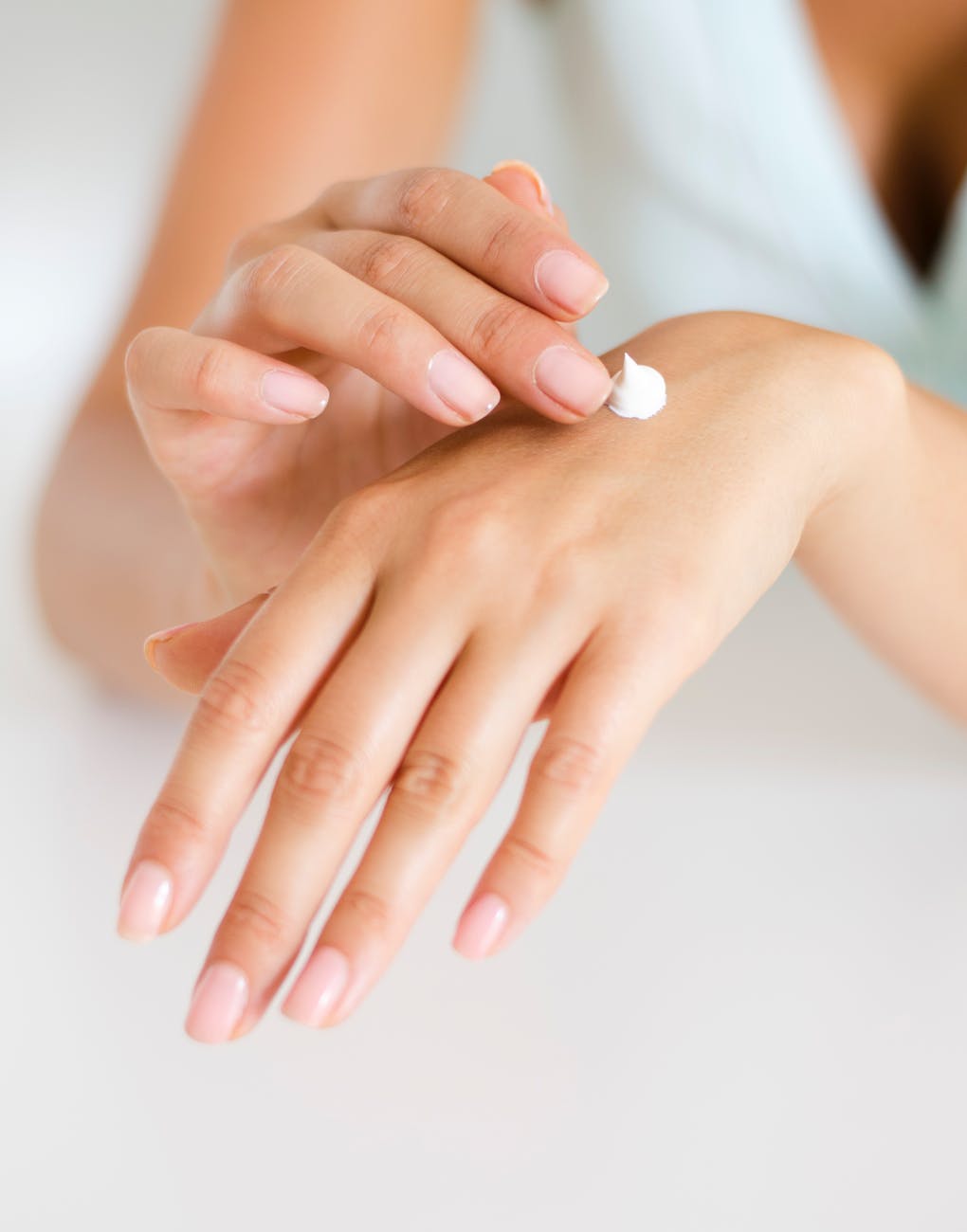Natural cosmetics
Endocrine disruptors in cosmetics: the ultimate guide
What exactly are endocrine disruptors and what distinguishes them from endocrine active substances? Which ingredients fall into this category? Where can I find a list of all endocrine disruptors and substances of potential concern? And what is the best way to avoid products containing endocrine disruptors? The following guide provides concise and well-founded answers to the most pressing questions regarding endocrine disruptors and safety in cosmetics and skincare products.

Aug
Over 25 % of conventional cosmetics and care products on the German market contain certain substances that can have negative effects on the human hormone balance. Endocrine disruptors. Surprisingly, these appear in all kinds of products without being immediately apparent to the consumer. Fortunately, awareness of questionable ingredients in cosmetics and food has increased considerably in recent years.
And yet, apart from lengthy specialist publications, there is hardly any information available in German-speaking countries on the subject of endocrine disruptors.
What exactly are endocrine disruptors and what distinguishes them from endocrine active substances? Which ingredients fall into this category? Where can I find a list of all endocrine disruptors and substances of potential concern? And what is the best way to avoid products containing endocrine disruptors? The following guide provides both compact and well-founded answers to the most burning questions regarding endocrine disruptors and safety in cosmetics and care products.
Table of contents:
- What are endocrine disruptors?
- What is the difference between endocrine disruptors and endocrine active substances?
- What effect do endocrine disruptors have on the body?
- What are the health effects of endocrine disruptors?
- Why are endocrine disruptors and questionable ingredients used in the manufacture of cosmetics at all?
- Which ingredients are endocrine disruptors?
- Is there a complete list of all endocrine disruptors?
- Where are endocrine disruptors contained?
- How can I avoid products with endocrine disruptors?
- Conclusion
What are endocrine disruptors?
Endocrine disruptors (EDs) are ingredients that, even in small doses can affect the hormonal balance of the body and thus cause damage to health. These are usually synthetically produced substances. They can be found in care and cosmetic products as well as in food and medicines. However, ED can also be found in everyday objects such as cosmetic containers, packaging and even children's toys. Frequently affected care and cosmetic products include UV sunscreens, creams, perfumes and shampoos. The substances of concern usually enter the body via the skin, but sometimes also via the mucous membranes and respiratory tract.
It has now been proven that ED can contribute to the development of diseases such as diabetes mellitus or hormone-sensitive cancers. The negative effects of ED on fertility, including infertility, have also been proven in both men and women. These substances pose a particular risk during pregnancy.

What is the difference between endocrine disruptors and endocrine active substances?
Endocrine active substances (EAS) are all substances that are in some way influence the hormone balance. However, the effects do not necessarily have to be negative. Some of these EAS are used deliberately in medicine, such as thyroid hormone replacement preparations or hormone replacement therapies during the menopause. However, if endocrine active substances have a negative or disruptive effect on the organism, they are referred to as endocrine disruptors (ED).
In short: EAS have an influence on the hormone balance, but this is not necessarily bad or undesirable. Only when the effects are negative do we speak of ED.
What effect do endocrine disruptors have on the body?
Endocrine disruptors impair hormone activity in humans, animals and plants. The hormone system or endocrine system regulates the growth, reproduction, development and behaviour of living organisms. The release of hormones via the endocrine glands, such as the pancreas, the gonads or the thyroid gland, triggers certain reactions in the organism.
When EDs enter the bloodstream via the respiratory tract, skin or stomach, these normal biochemical processes are disrupted or altered. As EDs have a similar structure to natural hormones, they can bind to the hormone receptors in the body's cells just like these. There they strengthen or weaken the natural effect of the hormones. They can also interfere with the regular breakdown of hormones, so that the hormonal balance becomes more and more disturbed in the long term.
What are the health effects of endocrine disruptors?
How exactly the individual endocrine substances work has not been fully clarified in many cases. The research behind this is intensive, but the topic is so complex and difficult to research that relatively little is still known. However, there are already reliable findings, and these give cause for further research. Researchers have gained some insights into this through numerous animal experiments and cell culture tests. However, there are sometimes serious species-specific differences. As a rule, these substances are not tested on humans, as the unknown risks are considered too high and too serious. What is certain, however, is that the consequences can be drastic and often even irreversible.
As mentioned at the beginning, ED can trigger various hormone-sensitive diseases. These include severe metabolic disorders, cancers, uterine fibroids, endometriosis, obesity and reduced fertility in men and women. During pregnancy, ED can contribute to the development of malformations and miscarriages. Prenatal exposure can, for example, lead to malformations of the reproductive organs and an increased risk of certain diseases.
EDs are also suspected of triggering premature breast growth and sexual maturity in young girls. This in turn favours the development of a number of life-threatening tumour diseases. The list of proven and potential health consequences of ED seems endless and frightening.

Why are endocrine disruptors and questionable ingredients used in cosmetics at all?
It is by no means the case that manufacturers deliberately add questionable or harmful ingredients to their cosmetics during production. Rather, certain ingredients have simply proven themselves and established themselves over the decades in the field of cosmetics and care products. This has mainly to do with the practical properties that characterise these substances. For example, they are often easier and cheaper to process, have a pleasant fragrance or are easy to apply to the skin. For a long time, people simply had no idea of the harmful effects on health.
A rethink has only gradually begun in recent years. This also goes hand in hand with research, which has been able to prove more and more facts about ED. Since then, many manufacturers have been making serious efforts to find safe alternatives to endocrine disruptors. However, as overcoming such an established practice is not an easy endeavour, the process will certainly take a very long time.
Which ingredients are endocrine disruptors?
How do I recognise endocrine disruptors in cosmetics?
A total of around 800 substances have so far been clearly classified as EDs. These include, for example, polychlorinated organic compounds that are or have been used in industrial manufacturing processes. Triazole compounds and dithiocarbamates, which are contained in herbicides and pesticides, are now also recognised EDs. Other recognised EDs are the frequently used phthalates.
There is a general consensus in research that many more substances actually fall into the ED category than previously assumed. However, there is still a lack of concrete and unambiguous research results that prove a harmful effect. This is aggravated by the fact that many substances only have a harmful or different effect in combination with other substances than on their own. This is difficult to prove clearly and in detail. Potentially harmful substances in the field of cosmetics include, for example chemical UV sun protection filters, aluminium salts, emulsifiers, silicones, synthetic fragrances, petroleum derivatives or parabens.

Is there a complete list of all endocrine disruptors?
Based on the results of numerous studies, the WHO, together with the UNEP (United Nationals Environment Programme), published a comprehensive Publication on the subject of ED. This report includes an overview of the most important endocrine disruptors and their specific effects on the organism. It summarises those 800 substances listed for which an endocrine-disrupting effect has already been proven or is suspected with clear indications. However, it must be borne in mind that this list only contains the substances that were known to science as EDs up to 2013. Despite its enormous scope, it therefore remains incomplete.
Where are endocrine disruptors contained?
Endocrine disruptors can can be found in a wide variety of cosmetics and care products. Hair and skin care products, for example, often contain parabens such as methylparabens or butylparabens. In turn, sun and face creams often contain benzophenones, ethylhexyl or methoxycinnamates. The questionable active ingredient triclosan can be found in numerous toothpastes and soaps. Many, or rather almost all, perfumes and creams available on the market that have not been tested as natural cosmetics contain synthetic fragrances. The list of possible areas of application for endocrine disruptors is long and almost impossible to keep track of.
The good news is that many endocrine disruptors have now been banned. Products with high levels of diethylstilbestrol, polychlorinated diphenyls and some pesticides have long since been banned from sale in Europe. In fact, it happens time and again that banned substances still appear in food and cosmetics. There is often no 1001TP3 certainty. In addition, products with lower proportions of ED are authorised under certain conditions. This is a common, but also very controversial practice.

How can I avoid products with endocrine disruptors?
Even though in most cases it is impossible for consumers to determine whether a product contains ED or not, there is a safe way to avoid such articles. The "magic word" in this context is Certified natural cosmetics or certified organic cosmetics. Well-known certificates include AIAB, Cosmebio, Cosmos, Demeter, Ecocert, Natrue, UK Soil Association and USDA Organic.
In contrast to conventional products, cosmetics with the seals of these natural and organic cosmetics certificates must not contain any endocrine disruptors. But beware: other claims such as "cruelty-free", "Fairtrade" or vegan certifications say nothing about whether the respective product is ED-free.
What you need to know, however: Alcohol is used in the production of many cosmetics. Properly dosed, it has a positive effect on the skin in many ways. In principle, it is not actually a questionable ingredient. However, alcohol in cosmetics is denatured, i.e. made unpalatable, in order to avoid the alcohol tax. For this purpose, endocrine disrupting phthalates such as diethyl phthalate are usually used. A certain degree of caution is therefore required with products containing alcohol. The substances used in the denaturing process are not usually directly apparent from the ingredients listed on the packaging. If in doubt, it is therefore advisable to ask the manufacturer or, even better, the certification body directly.
Conclusion
Whether in perfume, lipstick, hair dye or exfoliants, endocrine disruptors can be found in almost all cosmetics and skincare products. And that's not all - even the associated packaging material can contain ED and release it into the environment and the creams and products. We now know that endocrine disrupting chemicals can cause serious damage to humans and the environment. Countless diseases can be traced back to these ingredients. (Unborn) children are particularly at risk. This overall finding is worrying, and even more so as little is known about the long-term effects.
How can this be changed? As consumers, we can make a contribution by consciously choosing certified organic and natural cosmetics that are guaranteed to be ED-free. For a long time, many products containing ED were considered "standard" in the manufacture of cosmetics. Nevertheless, nothing stands in the way of establishing alternatives as the "new standard". Fortunately, there are more and more ways to consciously avoid ED.
Sources:
https://www.who.int/ceh/publications/endocrine/en/
https://www.dguv.de/medien/ifa/de/pub/grl/pdf/2017_122.pdf
https://www.umweltbundesamt.de/endokrine-disruptoren#1-bis-2
http://www.efsa.europa.eu/de/topics/topic/endocrine-active-substances
https://www.ages.at/service/sie-fragen-wir-antworten/endokrine-substanzen-kosmetik/
https://www.highdroxy.de/journal/hautpflege/mythos-alkohol-in-hautpflege/#:~:text=Der%20h%C3%A4ufigste%20einwertige%20Alkohol%2C%20der,keine%20Steuer%20darauf%20gezahlt%20werden.
https://www.bund.net/themen/chemie/toxfox/kosmetikprodukte/
https://de.wikipedia.org/wiki/Endokrine_Disruptoren